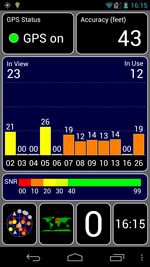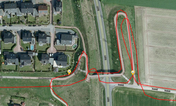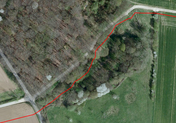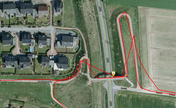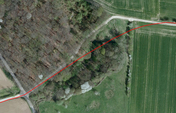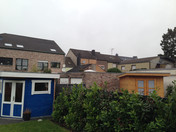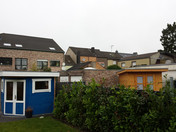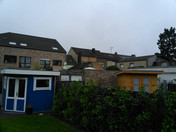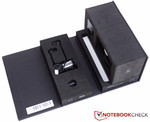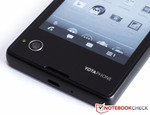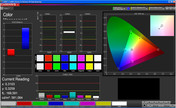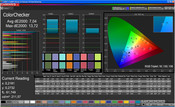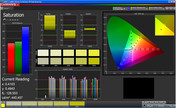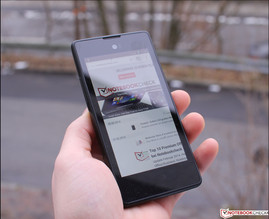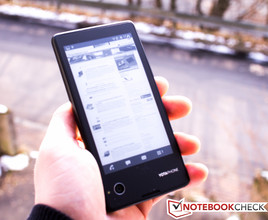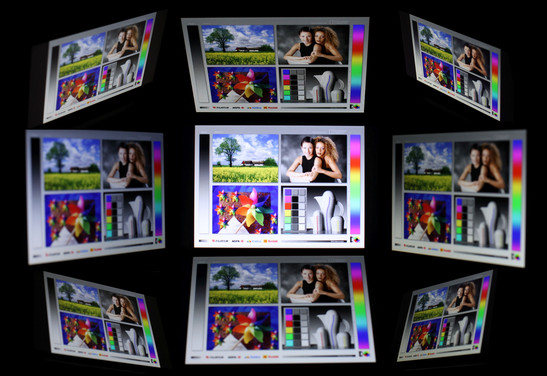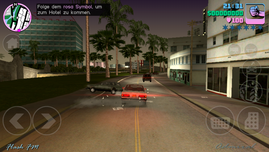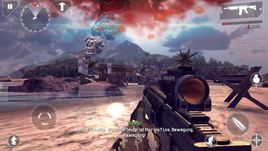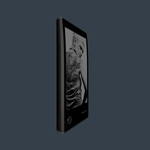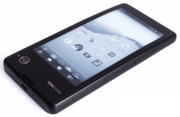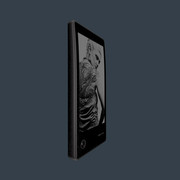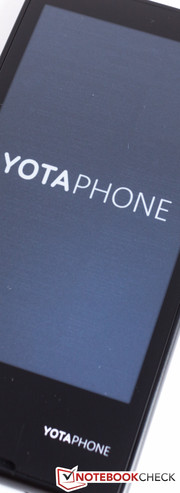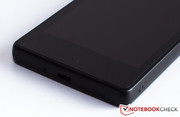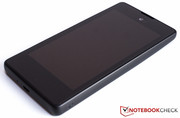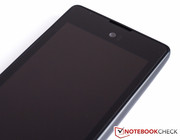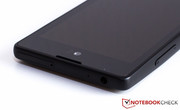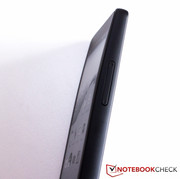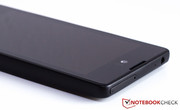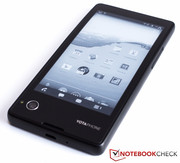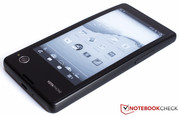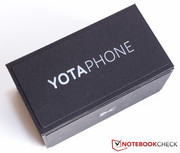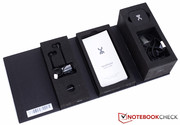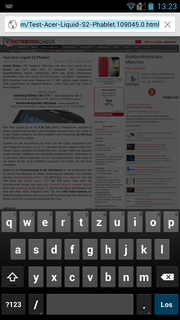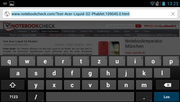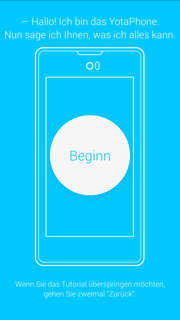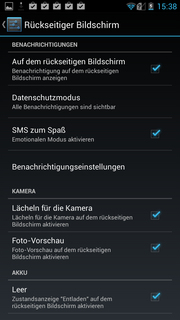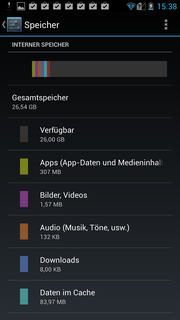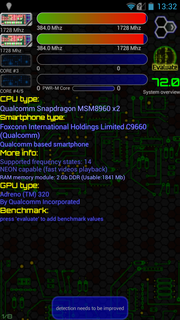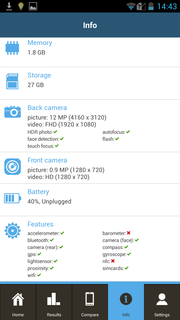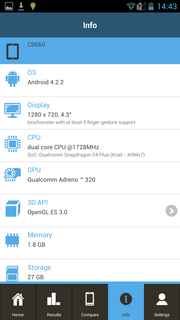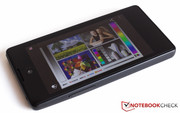Review Yota Devices Yotaphone Smartphone
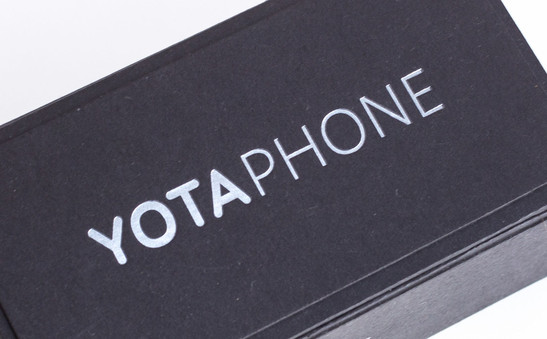
For the original German review, see here.
Another manufacturer tries to compete in the fierce smartphone market. The company "Yota Devices" has existed for a couple of years now, but they never produced a smartphone before. Their latest product, only called Yotaphone, has one unique feature. Both the front and the back are equipped with a 4.3-inch display. The main screen has HD resolution and can be operated via touch inputs. The display at the back is primarily intended for the reading of web content or books since it is a so called E-Ink screen – but more on that later.
The further hardware specs of the Yotaphone are not overwhelming and already familiar. The dual-core SoC is provided by Qualcomm and has the designation Snapdragon S4 Pro MSM8960T. It runs with 1.7 GHz and is supported by 2 GB memory. The smartphone supports LTE and the 13 MP main camera can record Full HD videos with up to 30 fps. Is the innovation of two displays productive or is it an obstacle?
Case
We have no doubt that the integration of two displays into one device was a tricky challenge for the engineers of the Yotaphone. This also means that they apparently did not put a lot of effort into the design in return. The Yotaphone is almost boring when you compare it with the HTC One, for instance. We really do not like the slant on the back since it gives the case an unsymmetrical appearance.
The frame of the case is made of polycarbonate and it is matte and catchy. The back of the case primarily consists of the second display and is coated with a matte material. An overall weight of 146 grams (~5 ounces) means that the Yotaphone is 3 grams (~0.1 ounces) heavier than the Motorola Moto G, but also 1.6 mm thinner in return (133.6 x 67 x 9.99 mm; 5.3 x 2.6 x 0.4 inches). We are positively surprised by the torsion resistance and stability of the smartphones since we expected bigger problems because of the second display. There is still a problem with the design since many users get a cover to protect their devices against scratches, but you have to protect a second display in this case. That pretty much only leaves a bumper, which cannot really protect the display on the back. We always thought about the unprotected display on the back – but this cannot be avoided with two screens.
Connectivity
The Yotaphone has no back cover, so you cannot open the device. The battery is integrated and it requires a lot of effort to replace it, but you will also lose the warranty. It has 32 GB integrated storage.
As usual, the micro USB port is on the bottom. There are no buttons at the right side of the case; the volume can be adjusted with a rocker at the left side. A 3.5 mm headset can be attached at the top. Yota Devices decided to use an unusual layout for the power button to save space. The micro SIM slot has a button at the right that can be used to turn the device on and off. Our enthusiasm is limited and we do not really like to waive the familiar power button, which is used for the HTC One or Samsung Galaxy S4.
Software
The manufacturer was forced to adjust the software because of the two displays and their different functionality. A tutorial explains the handling of the E-Ink display before the initial start-up including the login or creation of a Google account. After that, you quickly realize that you are dealing with a stock Android operating system. Version 4.2.2 is preloaded and there is not much bloat ware. There is currently no statement from the manufacturer about further updates.
Communication & GPS
The Yotaphone is equipped with the common wireless modules and even supports LTE (download: 43 Mbps). The smartphone can be used with the following frequencies: 800/1,800/2,600 MHz. If there are no LTE networks you can also use UMTS (900/1,800/2,100 MHz). It can communicate with WLAN routers according to the 802.11 a/b/g/n standards. Unfortunately, there were problems with the WLAN signal. Other mobile devices had a stable connection while the Yotaphone regularly lost the WLAN signal. This would not be a huge problem if the smartphone would automatically reconnect with the router, but we had to deactivate and then activate the WLAN module first. The signal is then reliable until the next connection loss. Bluetooth 4.0 can be used for short-range data transfers and we could not determine any problems. NFC and Infrared are however not supported.
The integrated aGPS module also supports the Russian GLONASS network. The connection is already reasonably accurate indoors and the comparison with the Garmin Edge 500 is not too bad. The complete route only shows a deviation of 300 meters (~328 yards) and we can clearly see that the GPS sensor lost the connection in the forest. This is also the reason that the smartphone only calculates the linear distance after the new satellite fix. The result is decent, but it cannot keep up with the iPhone 5S or iPhone 5C.
Telephone Functions and Voice Quality
There is absolutely no criticism in regard to the voice quality. We could not determine any background noises, even after multiple test calls. Voices are clear and easy to understand and the volume is sufficient as well, but obviously, the result depends on the current signal quality. A provided In-Ear headset ensures that you can also make calls when you are driving.
Cameras & Multimedia
The Yotaphone is equipped with two camera modules. A 1 MP front camera is primarily intended for video chats. The results of the small sensor are surprisingly good and still usable in darker environments. The main sensor is at the back and has a very high resolution of 13 MP. High-end competitors from LG or Samsung do not have a higher resolution either and the main camera is supported by an LED flash. Videos can be recorded in Full HD and with up to 30 fps. The position of the camera however is not perfect. You quickly block the sensor if you want to make a quick snapshot in portrait mode.
The results of the Yotaphone are good compared to other camera modules. Our test pictures are razor-sharp and show accurate colors. Only the picture "environment" shows that the small sensor did not get enough light, which results in darker peripheral zones. This effect is stronger with fading ambient light.
Accessories & Warranty
The box of the Yotaphone is very appealing. The black box can be unfolded and all the accessories are revealed. Even though there are not many provided accessories, you still get the most important things. Besides a modular charging cable, you also get an In-Ear headset.
The warranty period was not yet specified at the time of this review. The provided brochures refer to the website, but there is no information, either. We contacted the manufacturer and we will update this section as soon as we get the information.
Input Devices and Handling
We already mentioned that the handling of the two displays is a bit special. The main display also has a hidden navigation bar beneath it. You can also activate the "standard" navigation bar within the screen if you have problems with the gestures. A clear disadvantage of this solution is that you lose around 5 mm of the display content. The Yotaphone is almost wasteful with the space when you compare it with the LG G2. There is still a lot of room on all four sides of the display. The front display can recognize up to ten inputs simultaneously and executes inputs precisely and without noticeable delays. Operating the E-Ink display on the back is completely different since you cannot control it with touch inputs. It is operated with a touch bar (also embedded and invisible) beneath the screen. The required gestures are explained well in the tutorial. The E-Ink display has decisive advantages because the technology only consumes energy when the display content changes. The display can also be used under direct sunlight. We searched the internet for a recipe and transferred it to the E-Ink display via gesture to test the handling in practice. We could easily check the list of ingredients in the supermarket because the display was always active. Later we could just put the smartphone on the countertop to see the recipe. This is obviously also possible with a normal smartphone, but the improved comfort of the Yotaphone must not be underestimated.
Display
Both displays have the same size of 4.3 inches. The main screen can be operated with the usual touch gestures and up to ten fingers simultaneously. It has an HD resolution of 1280x720 pixels with 16.7 million colors. The display on the back however can only be operated with the embedded touch bar; it cannot recognize touch inputs. The E-Ink display has a resolution of 640x360 pixels and can show 16 different shades of gray.
We only performed our display measurements with the main screen. It has maximum brightness of 586 cd/m² and an average luminance of 552.9 cd/m² (over nine sectors) with a brightness distribution of 89%. This is similar to the Moto G and much higher than the LG G2 (84%). The black value is unfortunately somewhat high (0.89 cd/m²) and affects the contrast ratio. It is still good with 658:1 but cannot keep up with the Moto G (817:1) or LG G2 (1085:1).
| |||||||||||||||||||||||||
Brightness Distribution: 89 %
Center on Battery: 586 cd/m²
Contrast: 658:1 (Black: 0.89 cd/m²)
ΔE Color 7.04 | 0.5-29.43 Ø5
ΔE Greyscale 4.5 | 0.57-98 Ø5.3
Gamma: 2.05
CalMAN 5 and a colorimeter show that the representation of blue is too pale. The saturation also shows big deviations for green and red. The average DeltaE 2000 value of 7.04 is slightly raised, which is not surprising when you consider the mentioned color deviations. A gamma value of 2.05 on the other hand is on a good level. The grayscale presentation is improved with brighter shades of gray and gets very close to the ideal value.
Thanks to the very high average brightness, there are no problems with the visibility outdoors. The contrast ratio cannot quite keep up, but it is still high enough and does not affect the positive effect of the high luminance. But there is also a secret weapon when the sunlight is too bright. Just activate the E-Ink display with a two-finger gesture to duplicate the current display content.
Performance
The dual-core SoC of the well-known manufacturer Qualcomm is based on the Snapdragon S4 Pro-series. Each core has a clock of 1.7 GHz and is produced in a 28 nm manufacturing process. Graphics are handled by the Adreno 320 with a core clock of 400 MHz. The SoC is supported by 2 GB (LPDDR2) memory.
The dual-core processor has to compete with many quad-core CPUs in our performance benchmarks. We use three different tests to assess the performance. Our first test includes several synthetic benchmarks. The first Geekbench 3 result is very good, because it evaluates the single-core performance. The Yotaphone benefits from the clock of 1.7 GHz, but it cannot keep up with the rivals in the 32-bit Multi-Core test – quite the contrary. The other synthetic benchmarks show that our review unit can keep up surprisingly well with the high-end quad-core rivals.
| Geekbench 3 | |
| 32 Bit Multi-Core Score (sort by value) | |
| Yota Devices Yotaphone | |
| Motorola Moto G 1. Gen XT1032 | |
| Alcatel One Touch Idol X | |
| Google Nexus 5 | |
| 32 Bit Single-Core Score (sort by value) | |
| Yota Devices Yotaphone | |
| Motorola Moto G 1. Gen XT1032 | |
| Alcatel One Touch Idol X | |
| Google Nexus 5 | |
| 3DMark - 1920x1080 Ice Storm Extreme Score (sort by value) | |
| Yota Devices Yotaphone | |
| HTC One Mini | |
| Samsung Galaxy S4 Mini GT-I9195 | |
| Motorola Moto G 1. Gen XT1032 | |
| Alcatel One Touch Idol X | |
Other laws apply for the browser benchmarks. The Yotaphone has the chance to support the formerly shown performance, even though it is not easy against the high-end competition. Our review unit can beat the iPhone 5C in Mozilla's Kraken 1.1, but has no chance in Peacekeeper. The overall result is fair to middling, but worse compared to the synthetic benchmarks.
| Browsermark - --- (sort by value) | |
| Yota Devices Yotaphone | |
| HTC One Mini | |
| Samsung Galaxy S4 Mini GT-I9195 | |
| Alcatel One Touch Idol X | |
| Motorola Moto G 1. Gen XT1032 | |
| Google Nexus 5 | |
| Apple iPhone 5c | |
| Nokia Lumia 1520 | |
| Peacekeeper - --- (sort by value) | |
| Yota Devices Yotaphone | |
| HTC One Mini | |
| Samsung Galaxy S4 Mini GT-I9195 | |
| Alcatel One Touch Idol X | |
| Motorola Moto G 1. Gen XT1032 | |
| Google Nexus 5 | |
| Apple iPhone 5c | |
| Nokia Lumia 1520 | |
| Octane V2 - Total Score (sort by value) | |
| Yota Devices Yotaphone | |
| Google Nexus 5 | |
| Google Nexus 5 | |
| Mozilla Kraken 1.1 - Total (sort by value) | |
| Yota Devices Yotaphone | |
| Alcatel One Touch Idol X | |
| Google Nexus 5 | |
| Apple iPhone 5c | |
| Nokia Lumia 1520 | |
* ... smaller is better
Our last discipline evaluates the performance of the integrated flash storage. Google's Nexus 5 is, for instance, faster with sequential operations (read and write), but the situation changes with random accesses. Especially the Galaxy S4 Mini from Samsung cannot keep up with the Yotaphone and falls behind by up to 70%.
Videos & Games
The Yotaphone is powerful enough for current 3D games as well as Full HD video playback. We were not able to produce artifacts or other problems. Contrary to many quad-core rivals, the SoC unfortunately does not support QFHD videos. We could only hear the audio, even with third-party applications from the Play Store.
Emissions
Temperature
The two CPU cores produce quite a lot of heat. We measured an average temperature between 34 °C and 37.5 °C (93.2 and 99.5 °F; front and back) under load. The LG G2 with the high-performance SoC Snapdragon 800 is on a similar level, but the Moto G is around 5 °C cooler on average (~84 and 90 °F). Light workloads for the SoC quickly result in a temperature drop below 30 °C (86 °F) with 29.7 °C (85.5 °F) at the front and only 27.1 °C (80.8 °F) at the back. These results are normal and similar to the competition. The maximum temperature of the power supply unit is also acceptable with 39.9 °C (103.8 °F).
(±) The maximum temperature on the upper side is 40.4 °C / 105 F, compared to the average of 35 °C / 95 F, ranging from 21.9 to 56 °C for the class Smartphone.
(±) The bottom heats up to a maximum of 40.1 °C / 104 F, compared to the average of 33.8 °C / 93 F
(+) In idle usage, the average temperature for the upper side is 29.7 °C / 85 F, compared to the device average of 32.7 °C / 91 F.
Speakers
The E-Ink display will change into the "Player Mode" as soon as you start the music playback. It shows the current song and you can change the titles with the navigation bar beneath the display – a very useful feature in our opinion. The quality of the mono speaker is however not very convincing. The sound starts to distort and gets very tinny with around 50% of the maximum volume. You should use external speakers via Bluetooth 4.0 or the 3.5 mm stereo jack.
Energy Management
Power Consumption
Here we can see similarities with high-performance smartphones. The Yotaphone has a comparatively high energy consumption, both during idle and under load. Even the significantly more powerful LG G2 only has a maximum consumption of 4.8 Watts, but our review unit needs 0.6 Watts more. We will assess the effect of the high consumption on the battery runtime in the following section.
| Off / Standby | |
| Idle | |
| Load |
|
Battery Runtime
The former results already suggested it. The combination of high energy consumption and a battery capacity of only 1,800 mAh do not result in impressive battery runtimes. The Yotaphone does not even manage two hours under load with a runtime of 1 hour and 55 minutes before you have to recharge the battery. The Moto G manages more than twice that (04:04 hours). The other extreme scenario shows a similar picture. We measured little more than 13 hours with minimum display brightness and deactivated wireless modules, which is a bit meager. The Moto G is again far superior with 25:15 hours. Our last test uses an adjusted display brightness of 150 cd/m² while a script simulates web browsing on several websites. The result can obviously not change the poor results so far. The runtime of the Yotaphone (09:10 hours) is 40% shorter than the Moto G (15:30 hours).
Verdict
The Yotaphone realizes the very interesting concept of two screens. You can, for instance, quickly switch to the frugal E-Ink display if you want to read the paper. This display can also be used under direct sunlight. We could not find any wear on either of the displays during our review period, but it was a challenge to handle it with care. The device is theoretically always on one of the display because of the construction and is therefore susceptible to scratches.
The hardware of the Yotaphone is more than powerful enough for daily tasks and can handle every 3D game, only QFHD videos are not supported. Another drawback of the 1.7 GHz SoC is the comparatively high energy consumption. Even high-end devices from Samsung or LG are more frugal, which results in the meager battery runtimes. The Yotaphone is currently available for around 550 Euros (~$752). The concept of the smartphone is certainly very interesting, but the price is very high.


 Deutsch
Deutsch English
English Español
Español Français
Français Italiano
Italiano Nederlands
Nederlands Polski
Polski Português
Português Русский
Русский Türkçe
Türkçe Svenska
Svenska Chinese
Chinese Magyar
Magyar




